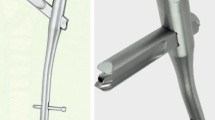Abstract
Introduction
Intramedullary fixation of intertrochanteric fractures has become the standard method of fixation especially in unstable fracture types. Even though there have been developments on implant design and technology, the surgical technique of reduction and implant positioning remains the mandatory factor in treating these fractures successfully. The advantages of nailing in the mainly elderly patients sustaining intertrochanteric femur fractures are a short lever arm and a lateral support in the trochanter supplied by the nail. The disadvantages are that it is often harder to achieve a closed reduction of a displaced fracture and to maintain the reduction with the intramedullary implant.
Tips and tricks
To obtain and maintain anatomic reduction and a secure fracture fixation, the surgical approach and fixation technique is of great importance. It starts with correct patient positioning, fracture reduction (accounting for varus dislocation and dislocation of flexed fragments), choosing the correct nail entry point and perfect lag screw positioning within the head-neck fragment and distal locking. To maintain the reduction achieved intraoperatively, the decision has to be made to use a cerclage wiring or to tolerate fracture gaps in the metaphyseal area. Intraoperative controlled compression of the neck or the subtrochanteric area is of great importance to reduce delayed unions or nonunions.
Summary
Intramedullary fixation of unstable per-, inter- or subtrochanteric fractures shows biomechanical advantages compared to extramedullry fixation techniques. Even though there have been several amendments and developments of implants, a better implant does not compensate for an inadequate surgical approach or deficient surgical techniques which are paramount for successful treatment. When fixing fractures with intramedullary nailing systems, the surgeon should always try to achieve anatomic reduction and a perfect implant positioning to allow immediate full weight bearing without an increased risk of cut-out, non-union and implant failure.
























Similar content being viewed by others
References
Zickel RE. A new fixation device for subtrochanteric fractures of the femur: a preliminary report. Clin Orthop. 1967;54:115–23.
Zickel RE. An intramedullary fixation device for the proximal part of the femur: 9 years’ experience. J Bone Jt Surg Am. 1976;58:866–72.
Harder SC. The Gamma nail for peritrochanteric fractures. J Bone Jt Surg Am. 1955;37:693–8.
Anglen JO, Weinstein JN. Nail or plate fixation of intertrochanteric hip fractures: changing pattern of pratice. A review of the American board of orthopaedic surgery database. J Bone Surg Am. 2008;90:700–7.
Guyer P, Landolt M, Eberle C, et al. The Gamma-nail as a resilient alternative to the dynamic hip screw in unstable proximal femoral fractures in the elderly. Helv Chir Acta. 1992;58:697–703.
Harrington P, Nihal A, Singhania AK, et al. Intramedullary hip screw versus sliding hip screw for unstable intertrochanteric femoral fractures in the elderly. Injury. 2002;33:23–8.
Leung KS, Chen CM, So WS, et al. Multicenter trial of modified Gamma nail in East Asia. Clin Orthop Relat Res. 1996;323:146–54.
Osnes EK, Lofthus CM, Falch JA, et al. More postoperative femoral fractures with the Gamma nail than the sliding screw plate in the treatment of trochanteric fractures. Acta Orthop Scand. 2001;72:252–6.
Simmermacher RK, Bosch AM, van der Werken C. The AO/ASIF proximal femoral nail (PFN): a new device for the treatment of unstable proximal femoral fractures. Injury. 1999;30:327–32.
Orthopaedic trauma association committee for coding and classification. Fracture and dislocation compendium. J Orthop Trauma. 1996;10(Suppl 1):1–154.
Barquet A, Francescoli L, Rienzi D, et al. Intertrochanteric/subtrochanteric fractures: treatment with the long Gamma nail. J Orthop Trauma. 2000;14:324–8.
Baumgaertner MR, Curtin SL, Lindskog DM, Keggi JM. The value of the tip-apex distance in predicting failure of fixation of peritrochanteric fractures of the hip. J Bone Jt Surg Am. 1995;77:1058–64.
McLaurin TM, Lawler EA. Treatment modalities for subtrochanteric fractures in the elderly. Tech Orthop. 2004;19(3):197–213.
Radford PJ, Needoff M, Webb JK. A prospective randomised comparison of the dynamic hip screw and the Gamma locking nail. J Bone Jt Surg Br. 1993;75:789–93.
Aune AK, Ekeland A, Odegaard B, et al. Gamma nail vs. compression screw for trochanteric femoral fractures: fifteen re-operations in a prospective randomized study of three hundred and seventy eight patients. Acta Orthop Scand. 1994;65:127–30.
Docquier PL, Manche E, Autrique JC, et al. Complications associated with gamma nailing: a review of 439 cases. Acta Orthop Belg. 2002;68:251–7.
Sadowski C, Lubbeke A, Saudan M, et al. Treatment of reverse and transverse intertrochanteric fractures with use of an intramedullary nail or 95 degree screw-plate: a prospective, randomized study. J Bone Jt Surg Am. 2002;84:372–81.
Hotz TK, Zellweger R, Kach KP. Minimal invasive treatment of proximal femur fractures with the long Gamma nail: indication, technique, results. J Trauma. 1999;47:942–5.
Valverde JA, Alonso MG, Porro JG, et al. Use of the Gamma nail in the treatment of fractures of the proximal femur. Clin Orthop Relat Res. 1998;350:56–61.
Conflict of interest
There is no conflict of interest.
Author information
Authors and Affiliations
Corresponding author
Rights and permissions
About this article
Cite this article
Ruecker, A.H., Rueger, J.M. Pertrochanteric fractures: tips and tricks in nail osteosynthesis. Eur J Trauma Emerg Surg 40, 249–264 (2014). https://doi.org/10.1007/s00068-013-0366-3
Received:
Accepted:
Published:
Issue Date:
DOI: https://doi.org/10.1007/s00068-013-0366-3




